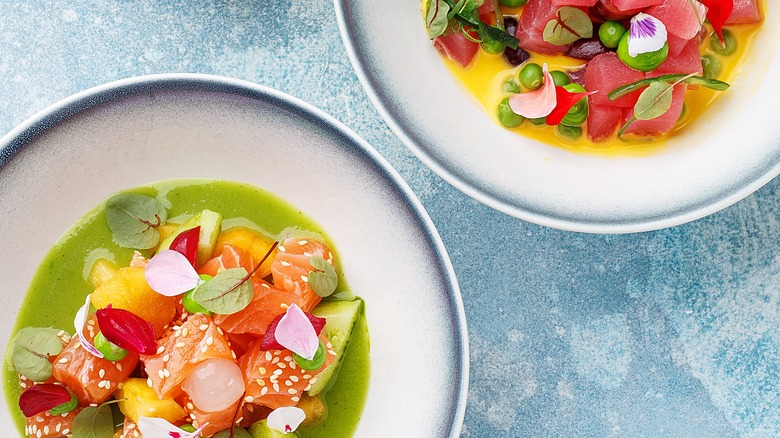The Big Difference Between Ceviche And Sashimi
Raw is very much in vogue right now; from seafood crudo to beef carpaccio, tartare to gravlax, fresh ceviche, and even fresher sashimi, all things uncooked have become cool. As a matter of fact, Statista confirms that between 2006 and 2016, Americans consumed 12% more raw fish. But, behind these labels, there are very stark differences between dishes like ceviche and sashimi. So, do you know what sets these uncooked culinary delicacies apart?
Our earliest ancestors followed a totally raw diet — that is, until the advent of fire. While raw foods never disappeared from the diets of European and Asian cultures, notes Forbes, there has always been a bit of apprehension from North Americans due to the danger of bacteria that would otherwise be eliminated with a bit of heat.
Given that the main ingredient in both ceviche and sashimi is raw fish, it's crucial to source only the highest quality seafood to avoid any risk of food poisoning. But while they both technically fall into the uncooked category, that doesn't mean that they have the same origins, preparations, and flavors — not to mention that one of the two dishes isn't even totally raw.
Raw, but not really
Uncooked isn't the same as being raw. Cooking generally requires heat application to food, whereas raw food does not. But, Greatist explains that through techniques like marinating and curing with citrus, foods can undergo a process called denaturation, where heat or citric acid can change the proteins in raw fish to turn flesh firm and opaque; therefore, "cooking it."
A Peruvian specialty, ceviche is a dish where pieces of raw fish (white fish, shrimp, octopus, etc.) marinate in a lemon, lime, or orange juice anywhere between 10 to 25 minutes, depending on how well done you'd like your fish to be, Southern Living shares. Typically served with toppings like onions, tomatoes, peppers, and cilantro, ceviche is bursting with vibrant acidity and zest that's balanced by an overwhelming sense of freshness.
In comparison, sashimi is totally raw and without frills. A staple in Japanese cuisine, sashimi describes any raw food (meat or fish) thinly sliced across the grain, notes Michelin Guide. However, seafood like tuna, salmon, scallop, and uni is commonly eaten as sashimi and often displays a subtle, fresh flavor and smooth texture. Lacking a bed of rice like sushi, sashimi is instead served with ponzu, citrus, or soy sauces and wasabi.
While the primary materials are the same, sashimi is rarely marinated or seared, meaning it's totally raw, unlike ceviche that's been marinated and "cooked" despite never being close to a flame — the more you know!

